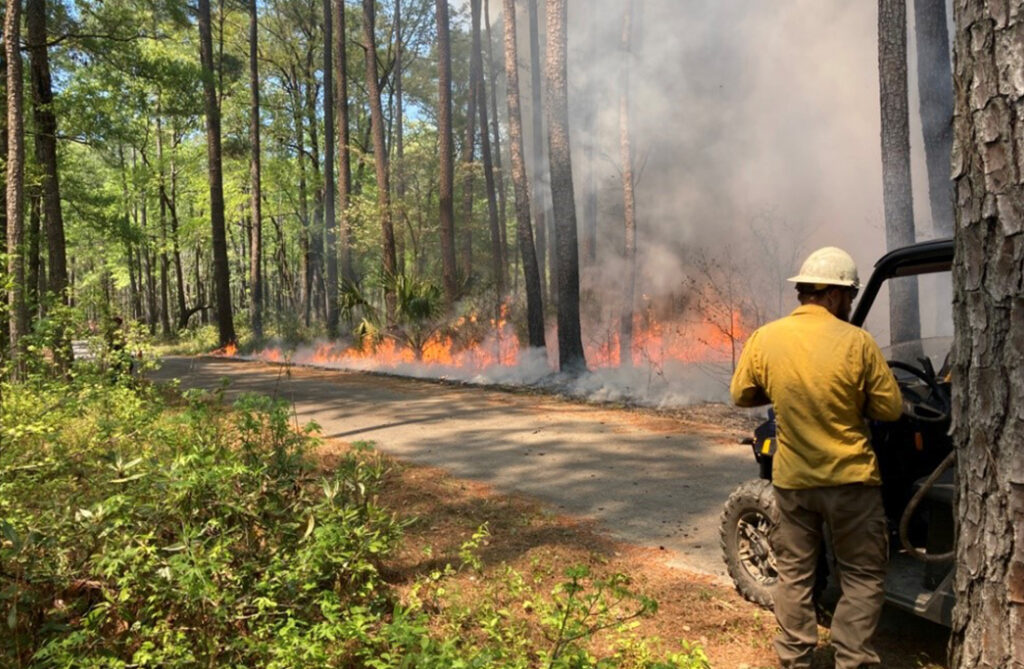BY JODI PETERSON
Surveying freshwater fisheries and monitoring beluga whales in Alaska. Planting native flowers and trees in Hawaii. Counting pronghorn and capturing endangered mice in Wyoming. Creating maps with geographic information systems software, setting up youth deer hunts, and improving red-cockaded woodpecker habitat in Florida. Developing a virtual reality exhibit about prehistoric archaeological sites in Utah.
These are just some of the experiences that participants in CEMML’s early career development program have had over the last few years. The program gives college students and recent graduates opportunities to work at military installations on natural and cultural resource projects. So far, 39 participants have worked at dozens of bases as seasonal technicians. They all learned new skills, gained mentors, and made career-aiding connections—and they even got paid while doing it!

The program was started by CEMML Principal Investigators Jennie Anderson and Amanda Wallander. “Most students are never exposed to careers in military lands management,” said Anderson. “We wanted to give diverse students from multiple universities a chance to get hands-on experience in working at military bases and prepare them to successfully seek careers in this field.”
While the program’s initial focus was on internships through the Air Force, Anderson and Wallander are now expanding it to also offer mentorships and early-career opportunities through multiple branches of service. Participating students earn college credit at their host university, if needed. Most positions last anywhere from 3 or 4 months to a full year. Under the guidance of military natural resource managers, these seasonal workers gain firsthand experience with practical environmental and cultural resource management. They learn how the Department of Defense manages 25 million acres of diverse, often pristine federal lands—which are home to hundreds of rare and endangered species and their habitats, archaeological treasures, and historical landmarks.
The seasonal jobs focus on areas such as outdoor recreation, threatened and endangered species conservation, invasive and native vegetation management, ecosystem restoration, regulatory compliance, GIS, and artifact inventory and cataloging. Through hands-on projects and mentoring, participants learn a sustainable and comprehensive approach for managing resources, get a better understanding of the roles of environmental staff, and gain experience with tools and techniques to directly support the military environment. Training, supervision, and mentorship come from both military staff and CEMML experts, with regular check-ins and plenty of support.
“We give our seasonal workers all the information they need to succeed, including rules and regulations for working on Department of Defense lands, security procedures, and background information on the installation they’ll be working at,” said Wallander. “They also get issued a laptop or iPad, work gloves, waterproof boots, and whatever other gear they need.”

Once the new technicians report to the host installation, the learning—and the on-the-ground work—begins. They dig into projects and quickly become part of the on-base team. Many have the chance to design and implement projects from the ground up. After their position ends, with several months of solid experience and newly-acquired skills under their belts, technicians often get job offers. Many have been hired as full-time federal employees at the host installation or elsewhere. Others get jobs at CEMML itself, state wildlife agencies, and various nonprofits or environmental consulting firms.
Recent participants reflected on their experiences in essays that they wrote after finishing the program. “Having this level of autonomy has been greatly beneficial to my professional growth and technical skills. I have never felt so supported in terms of creating a research question and being given the tools to investigate it myself,” wrote Olin Halsten, who worked as a fisheries research specialist at the Alaska Pacific Regional Support Center. At Hill Air Force Base in Utah, cultural resources intern Elizabeth Shikrallah wrote, “This internship was one of the most educational I have ever had … I got to develop my survey skills, both archaeological and architectural.” Amber Bumgardner, who was a wildlife and outdoor recreation technician at Florida’s Eglin Air Force Base, now works full-time for CEMML. She wrote, “I learned new tactics for wildlife management strategies of various species, gained new friends, and built relationships across different cooperators and agencies. The experiences I had will make me very competitive for future positions in wildlife management.”
CEMML recognizes the great worth of this early career development program to current students and recent graduates as they put their education to use, and also the impact this program has in conserving some of our country’s most valuable and precious resources. Anderson and Wallander are working to expand the program, continually adding interesting and exciting opportunities, improving the mentorship aspect of the program, and getting the word out on how fulfilling a career in military lands management can be.
 Clarissa Chipman helped band burrowing owls at Utah’s Hill Air Force Base. Courtesy Clarissa Chipman.
Clarissa Chipman helped band burrowing owls at Utah’s Hill Air Force Base. Courtesy Clarissa Chipman.